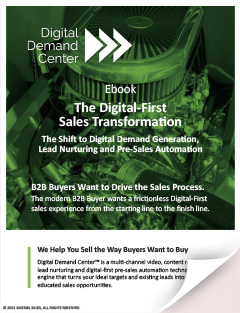Why cold callers cannot- and should not-have to handle all of marketing on their own
At Gabriel Sales, we have not needed to staff a fully dedicated cold caller in over 12 months.
While there are many factors at play, we see this as an indication of the success you can experience when you make it easy for your buyers to self educate with an integrated sales and marketing strategy.
Long before we began offering integrated sales and marketing outsourcing services to our clients, we made a commitment to implementing the approach ourselves. On the technology side, we were early adopters of marketing automation and CRM systems. On the marketing side, we have been publishing relevant content and executing eProspecting campaigns and nurturing programs for over three years.
We didn’t get there over night. After committing to this integrated approach for about eighteen months, our dependency on cold callers was dramatically diminished.
This is because the integration of content and technology has allowed us to take our early stage sales messages and turn them into digital content—blogs, white papers, webcasts, etc.—that can be shared one-to-many. Because our marketing automation platform tracks content engagement by prospect, we can start interacting with our prospects early in their buying cycle digitally with our calling resources simply stewarding them through their educational process.
The result is a win-win situation: Our prospects are now able to take themselves through their own discovery and education, on their time frame based on their own business drivers. Our calling resources can then watch this engagement, and they are able to see when it makes sense to reach out.
Now, instead of placing endless follow up calls to companies that may or may not be ready to buy, we are able to use marketing automation and digital sales tools to see what prospects are interacting with what content. We then have a better idea of not only what people are interested but also what they are specifically interested in. Additionally, our calling team is able to be helpful as opposed to disruptive to the buyers’ day-to-day business activities.
When we do see sufficient interest to indicate that it makes sense to follow up with prospects, enough trust has been established digitally that the experience on both sides is about deepening the relationship and moving towards a common goal.
On our end, we know who the prospect is and what title he/she holds (e.g. admin vs. executive). We also know what webpages he/she has visited, what videos were watched, what social media posts were clicked on, etc. This makes us much more effective in helping them to buy or not buy the right solution.
On the prospect side, he/she knows who we are and what we do and also has a general feel of the company culture (e.g. brand attributes). The prospect has also been given the chance to educate himself/herself enough to speak intelligently about our solution. Typically, they have a much greater grasp of what their needs and priorities are.
So now, when we call a prospect for the first time, instead of hearing:
“Who are you? What is this about? Sales and marketing? Oh, I’m not the right person to talk to about this.”
We hear,
“Oh yeah, that white paper on marketing automation was really helpful. I was looking on your site and see that you guys offer marketing automation consulting, could you tell me more about that?”
By allowing our content marketing campaigns to do the work before we get on the phone, both the tone and content of the initial calls are radically different from the typical disruptive calling experience. Whereas the best response you can expect to get from a cold call is, “Sure, send me some information,” calling someone who has already been through a fair amount of your content is generally a ten-minute qualifying conversation right out of the gate.
Rather than pitching ourselves, the call is spent understanding the needs of the buyers.




